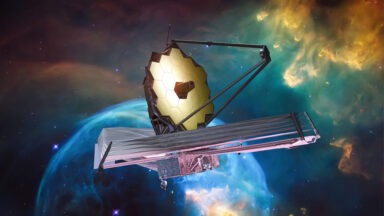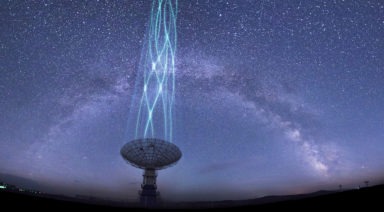The Chronovisor: The Vatican’s Mysterious Time Travel Device

While many regard H.G. Wells as a genius for inventing the idea of the time machine in his novel, “The Time Machine,” some believe he was revealing a top-secret capability. Since his novel was first published in 1895, thousands of books, articles, and videos have followed, documenting curious accounts of time travel and dimensions beyond the wildest of imaginations.
One of these works, Father François Brune’s 2002 book, “Le Nouveau Mystere du Vatican,” brings a forgotten time-travel device called the Chronovisor, back into the public eye — or at least into the minds of conspiracy theorists.
Brune, who learned of the device in the early 1960s, swears the Chronovisor exists. A day after he met scientist-priest Father Pellegrino Ernetti for the first time, the two were sailing along the Grand Canal of Venice discussing biblical interpretations, when Ernetti explained that theories and interpretations were unnecessary when one could see the truth for himself. He explained to Brune how the Chronovisor functioned, allowing the viewer to see and hear past and future events. The story of his full account is included in Brune’s book.
With a little digging, researchers will find the first mentions of the Chronovisor in a 1972 article published in the Italian magazine “La Domenica del Corriere,” entitled, “A machine that photographs the past has finally been invented.”
What is the Chronovisor and Who Allegedly Created It?
Belonging to the Vatican, the Chronovisor time machine is heralded as one of the papacy’s best-kept secrets. The device is said to be replete with three precious alloys, cathodes, dials, and levers, and it can display myriad historical events in biblical and Roman history. Acting as a sort of television, the Chronovisor has even supposedly verified the existence of Jesus Christ and broadcast his crucifixion.
The Chronovisor time machine is claimed to have been invented in the 1950s by a dedicated and secret team of Italian scientists, including physicists Enrico Fermi and Pellegrino Ernetti. Critics may take credibility issues with the fact that Ernetti, a Benedictine monk, eventually became a Catholic priest and a working exorcist.

However, Enrico Fermi’s reputation is nothing to scoff at. He was awarded the Nobel Prize for Physics in 1938 “for his demonstrations of the existence of new radioactive elements produced by neutron irradiation and for his related discovery of nuclear reactions brought about by slow neutrons.”
Fermi’s scientific notoriety is interesting enough to take a closer look at the Chronovisor, but was he really capable of engineering a time machine with his team? Some argue that this was the case. Still, Fermi could never defend the invention and its workings either way, because his name was not associated with the project until 1992, he left this earth in his 1954 death.
Who Were The Others Involved With the Creation of the Chronovisor?
The rest of the Chronovisor’s team of inventors has remained anonymous. Except for one other name: the famous, or infamous, Wernher von Braun, a one-time Nazi SS member and eventual esteemed NASA rocket scientist. Von Braun had also died by the time his name became publicly linked to the project. However, it is known that he had been working on the Third Reich’s Die Glocke, or Nazi Bell, during the final years of World War II.
The Chronovisor may have represented another link between the Nazis and the Vatican, who maintained close ties during the war. It therefore wouldn’t be shocking if the Chronovisor technology had been shared between the two entities.
Evidence of the Vatican Chronovisor
Evidence of the Chronovisor is flimsy, as far as scientific standards go, comprised of dubious photographs, including a Chronovisor photo of Jesus on the cross.

The Chronovisor’s alleged photo of Jesus next to a South American church’s statue of Jesus
Ernetti also claimed to have seen the Roman poet Quintus Ennius’s lost play Thyestes and then transcribed its scenes for the public. Doubt has also been cast upon this transcription, with Princeton University’s Professor Katherine Eldred (an expert on Thyestes ) explaining that the version Ernetti produced is not only too short but also contains Latin words that wouldn’t have been used until 200 years after Ennius’ time.
When considering the veracity of the Chronovisor, one might refer to T.L. Sherred’s science fiction novella, “E for Effort,” published in 1947, just before the supposed invention of the Vatican’s device. In his novella, Sherred writes about a time-viewing device with characteristics that bear a striking resemblance to the Chronovisor.
Is Time Travel Even Possible?
Savvy researchers may agree that, while time travel may indeed be possible, the Chronovisor is not necessarily a medium for it. Physicist and cosmologist Stephen Hawking has discussed the possibilities of time travel, explaining in one instance, “If we want to travel into the future, we just need to go fast. Really fast. And I think the only way we’re ever likely to do that is by going into space.”
Physicist Fred Alan Wolf has suggested that time travel is possible because “it really has to do with a rather delicate relationship that exists between mind and matter…[W]hat time travel is really all about is learning how to move in and out of that realm where things get defined by the mind.”
Unfortunately, Ernetti never provided a detailed explanation as to how his time travel device was fashioned or how it worked, except to mysteriously claim that it ran by “processing residual electromagnetic radiation left over by numerous processes.”
Also unfortunate is that the Chronovisor, if it ever did exist, could never be studied and replicated, for Ernetti claimed he had to dismantle it to keep it out of the hands of evil. That said, many believe the Chronovisor still exists, safely hidden away in the walls of the Vatican, remaining one of its best-kept secrets.
The Vatican Time Machine: Myth or Reality?
The Chronovisor is a topic of great interest, whether based on fact or fiction. For some, it is more than just an object of scientific curiosity; it represents the convergence of technology, faith, and the desire for knowledge lost to time. This alleged time machine, in a world where the line between the tangible and divine is often blurred, symbolizes the unending quest to unravel the mysteries of time.
If the Chronovisor does exist, its revelations could challenge the fundamental principles of the Christian faith and the foundations of the Catholic Church as a whole. Regardless of whether it is a groundbreaking invention or an intricate hoax, the mystery of the Chronovisor is a reminder of our ceaseless curiosity and the constant pursuit to understand God, religion, and the history of humanity.
How Can We Imbue Artificial Intelligence With Compassion?

Can artificial intelligence be designed to be compassionate?
Given the ever-increasing pace of development in the world of artificial intelligence, many scientists and researchers are calling for more rigorous regulation to avoid potentially disastrous consequences. And the idea of building positive human values, such as compassion into AI design is quickly gaining momentum
Gregg Braden is a former senior computer systems designer, best-selling author, and leader in the fields of science and spirituality.
“The topic of compassion in artificial intelligence, while in many circles people have never heard of it, in the circles of science and technology it’s a hot topic,” Braden said. “In one way or another, this topic is going to touch each of our lives, and it’s going to happen faster than we have been led to believe. Humankind is at a crossroads right now, for the first time in the history of our species, where we have the technology to support the philosophy of the way we think about ourselves and our relationship to the world around us, to software, to robots, to artificial intelligence, (and) to machine intelligence.”
“The development of AI is moving at an exponential rate, it’s no longer linear, and it’s not regulated,” he said. “We’re talking about AI that is going to be running huge national and international systems of electricity, power, energy, water, food, and weapons systems that are the reality of our lives today. So, if we’re going to allow artificial intelligence to play a vital role in our lives, we want that intelligence to be more than intelligent — we want it to be smart, we want it to be intuitive, and we want it to be compassionate, as it makes the decisions that affect all of our lives.”



































